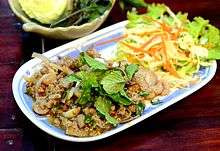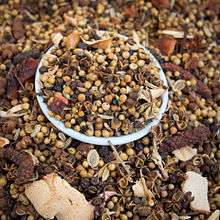Larb
|
Larb made with cooked beef in Vientiane, Laos | |
| Alternative names | Laap, Larp, Lahp, Lahb, Laab |
|---|---|
| Type | Salad |
| Place of origin | Laos and northern Thailand |
| Creator | Lao cuisine |
| Main ingredients | Meat (chicken, beef, duck, turkey, pork, or fish) |
| Variations | Several across the world |
|
| |

Larb (Lao: ລາບ; Thai: ลาบ, rtgs: lap, pronounced [lâːp], also spelled laap, larp, lahb or laab) is a type of Lao meat salad[1][2][3] that is regarded as the national dish of Laos. Larb has also been referred to as an "unofficial" national dish of Laos.[4] It is also eaten in the Isan region, an area of Thailand where the majority of the population is of the Lao ethnicity. The Hmong people, an ethnic minority group in Laos who migrated into the country in the nineteenth century, have adopted the Lao dish along with many other elements of Lao cuisine. Outside of Southeast Asia, larb is served in Lao, Thai, and Hmong communities in the U.S., France, and UK. Local variants of larb also feature in the cuisines of the Tai peoples of Shan State, Burma, and Yunnan province, China.[5]
Types of larb
Lao/Isan Style
Larb is most often made with chicken, beef, duck, fish, pork or mushrooms, flavored with fish sauce, lime juice, padaek, roasted ground rice and fresh herbs. The meat can be either raw or cooked; it is minced and mixed with chili, mint and, optionally, assorted vegetables. Roughly ground toasted rice (khao khoua) is also a very important component of the dish. The dish is served at room temperature and usually with a serving of sticky rice and raw vegetables.[6][7]
Tai Nyuan/Lanna Style

The larb from northern Thailand - larb Lanna - is very different from the internationally more well-known Lao style larb. The northern Thai larb of the Tai Nyuan/Khon Muang (Northern Thai people)[8] does not contain fish sauce and is not sour, as neither lime juice nor any other souring agent is used. Instead, the northern Thai version uses an elaborate mix of dried spices as flavoring and seasoning which includes ingredients such as cumin, cloves, long pepper, star anise, prickly ash seeds and cinnamon amongst others, derived from the location of northern Thailand's Lanna Kingdom on one of the spice routes to China,[9] in addition to ground dried chillies, and, in the case of larb made with pork or chicken, also the blood of the animal used. The dish can be eaten raw (larb dip), but also after it has been stir-fried for a short time (larb suk). If blood is omitted from the preparation of the stir-fried version, the dish is called larb khua. There is also a kind of larb called larb luat (Lao: ເລືອດ) or lu (Thai: ลู่). This dish is made with minced raw pork or beef, raw blood, kidney, fat and bile, and mixed with spices, crispy fried onions, fresh herbs and other ingredients. Larb and its other variations are served with an assortment of fresh vegetables and herbs, and eaten with glutinous rice.[10][11][12][13][14][15] This version of larb is viewed as having originated in the town of Phrae, in northern Thailand.[16] This style of "larb" can also be found in parts of northern Laos.
Saa
Saa (Lao: ສ້າ) is a term used to describe a larb-like dish with the meat sliced thinly rather than minced. [17] A similar dish exists in Vietnam known as bo tai chanh.
Nam tok
Nam tok (Lao: ນ້ຳຕົກ, Thai: น้ำตก) is a Lao and Thai word meaning waterfall. The name is derived either from the dripping of the meat juices during the grilling or from the juices running out of the medium rare beef as it is sliced. It refers to a popular Lao meat dish in both Laos and Isan, where it is commonly known as ping sin nam tok (Laos) or nuea yang nam tok (Thailand). This dish can be regarded as a variation on the standard larb, and is made from barbecued pork or beef, usually the neck, which is sliced to bite-size pieces. The meat is then brought to a boil with some stock to create sauce. The heat is turned off, and then sliced shallots, ground roasted rice, chili powder, lime juice, and fish sauce are added, along with shredded coriander leaves, spring onions and mint leaves.[18]
Consumption of raw larb
The consumption of larb and lu made with raw pork has led to several cases of human Streptococcus suis infections in Thailand, some of them with a deadly result.[19]
The consumption of raw fresh water fish can lead to an infection by Opisthorchis viverrini (Southeast Asian liver fluke), a parasitical flatworm that can live for many years inside the human liver.
See also
References
- ↑ Green Mangoes and Lemon Grass. Books.google.com. Retrieved 21 January 2015.
- ↑ Southeast Asia on a Shoestring. Books.google.com. Retrieved 21 January 2015.
- ↑ How to Cook Meat. Books.google.com. Retrieved 21 January 2015.
- ↑ Webb, L.S.; Roten, L.G. (2009). The Multicultural Cookbook for Students. EBL-Schweitzer. ABC-CLIO. p. 94. ISBN 978-0-313-37559-0. Retrieved June 26, 2016.
- ↑ "Laab Mu - Tai Koen People Style". Cooking.in.th. Retrieved 21 January 2015.
- ↑ Laos in Pictures. Books.google.com. Retrieved 21 January 2015.
- ↑ "Isan Meat Salad ( Larb )". Nationmultimedia.com. Retrieved 21 January 2015.
- ↑ "History of Laos - Lonely Planet Travel Information". Lonelyplanet.com. Retrieved 21 January 2015.
- ↑ "Andy Ricker of Pok Pok Explains Thai Laab". SoundCloud. Retrieved 21 January 2015.
- ↑ "Phrik lap - Lanna Food - Northern Thai Information Center, Chiang Mai University Library". Library.cmu.ac.th. Retrieved 21 January 2015.
- ↑ "Lap kai - Lanna Food - Northern Thai Information Center, Chiang Mai University Library". Library.cmu.ac.th. Retrieved 21 January 2015.
- ↑ Post Publishing PCL. "Bangkok Post : The world windows to Thailand". Bangkokpost.com. Retrieved 21 January 2015.
- ↑ "Lu (mainly blood mixed with some spices) - Lanna Food - Northern Thai Information Center, Chiang Mai University Library". Library.cmu.ac.th. Retrieved 21 January 2015.
- ↑ "This website is currently unavailable.". Chef-a-gogo.com. Retrieved 21 January 2015.
- ↑ "Lap pla - Lanna Food - Northern Thai Information Center, Chiang Mai University Library". Library.cmu.ac.th. Retrieved 21 January 2015.
- ↑ "Laap country - Austin Bush Photography". Austinbushphotography.com. Retrieved 21 January 2015.
- ↑ ":: Laap (ลาบ), Saa (ส้า), Luu (หลู้), gaawy (ก้อย), Nam Dtohk (น้ำตก) – an Ethno Culinary Journey ::". thaifoodmaster.com. Retrieved 22 January 2015.
- ↑ ":: Laap (ลาบ), Saa (ส้า), Luu (หลู้), gaawy (ก้อย), Nam Dtohk (น้ำตก) – an Ethno Culinary Journey ::". thaifoodmaster.com. Retrieved 22 January 2015.
- ↑ "News 2010". B-safe.ch. Retrieved 21 January 2015.